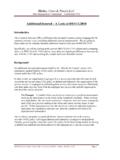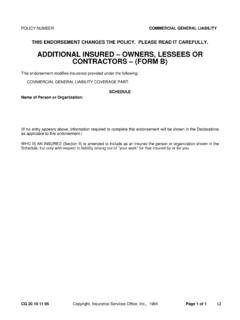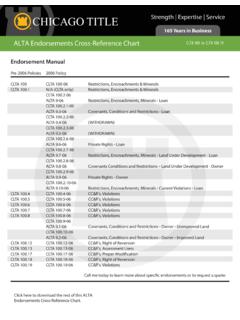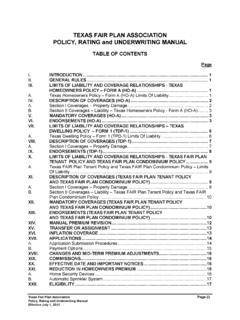Transcription of “Certificates of Insurance” and “Additional Insured ...
1 87 Certificates of insurance and additional Insured Coverage: Maximize Value and Avoid Pitfalls robyn andersonCoverage IssuesThe Basics: Who Is an additional Insured ? Starting with square one, it s important to un-derstand who an additional Insured is. It s not a named Insured . And it s not an additional named Insured . These are the entities to whom the policy is issued. Named insureds have the greatest respon-sibilities ( , premium payment) and rights ( , ability to negotiate terms) under the policy. An additional Insured , in contrast, is gener-ally a person or entity that is doing business with the named Insured (or additional named insureds), Parties doing business together commonly request and receive additional Insured pro-tection, but rarely understand the full benefits and risks associated with the coverage.
2 What s more, many companies are sitting on one or more certificates of insurance purportedly evidencing their additional Insured protection, but certifi-cates of insurance are not a foolproof way to ensure actual coverage. The following overview attempts to demystify some of the nuances of additional Insured coverage and provides useful tips to help your company ensure that its additional Insured procedures and practices are effective. Certificates of insurance are not a foolproof way to ensure that you have the additional Insured coverage you need. Here s what to ask for as proof of appropriate The John Liner Reviewsuch that it makes sense to add the other person or entity as an additional Insured to the policy by endorsement or amendment.
3 additional insureds have fewer responsibilities and rights under the policy. They are not responsible for premiums, and they have no direct control over the maintenance or terms of the Insured coverage is commonly used to fund or reinforce the ability to pay an indemnity obligation between parties that do business Seek additional Insured Status?There are several reasons why an entity would seek additional Insured status: 1. to fund or reinforce an indemnity obligation; additional Insured coverage is commonly used to fund or reinforce the ability to pay an in-demnity obligation between two parties that do business together.
4 When coupled with an in-demnity undertaking, it s a belt-and-suspenders approach to the risk transfer. That is to say, the scope of an indemnity agreement can be (and oftentimes is) very different from the scope of direct coverage under an additional Insured endorsement. If the indemnity obligation is enforceable, the indemnitor may be able to respond to the risk by using its contractual lia-bility coverage under its general liability policy. On the other hand, if the indemnity obligation is found to be unenforceable ( , some states prohibit sole-fault indemnification), then the risk transfer may nonetheless be completed by virtue of the direct coverage afforded to the ad-ditional Insured (although some states prohibit the parties from doing through insurance what they cannot do through private agreement).
5 In the end, the additional Insured coverage provides some reassurance that the indemnitee may have protection even if the indemnitor is financially or legally unable to satisfy its con-tractual indemnity to prohibit subrogation by the named Insured s insurer against the additional Insured for the ad-ditional Insured s own fault or negligence;As a general matter, an insurer that pays a claim can subrogate to the rights of the Insured to seek reimbursement from the party at fault for the underlying claim. There s an antisubrogation rule, though, that applies to insureds under the policy, including additional insureds. Thus, by adding a business contact/indemnitee as an additional Insured , you can decrease the likeli-hood that the named Insured s insurer will pay a claim and then turn around and subrogate against the business contact/indemnitee for reimbursement of the paid claim if the businesss contact/indemnitee is at fault.
6 This antisubro-gation rule prevents insurers from passing the cost of a loss to its own Insured (or additional Insured ) and also ensures that the insurer will not have an adverse incentive to provide less than a vigorous defense for the additional Insured . 3. to directly pay defense costs of the additional Insured ; Another benefit at least to the additional Insured is to have someone else s insurer foot the cost of defense up front. The duty to defend under a policy is broader than the duty to indemnify. So, as long as a claim even po-tentially falls within the scope of coverage, the insurer s duty to defend is triggered.
7 As a result, it s to the advantage of the additional Insured to have this broad defense provided at the cost of the named Insured s insurer. Oftentimes, defense costs under the policy will be paid in addition to the policy limits, rather than erode the policy limits. Thus, the defense obligation is valuable. 4. to reduce impact on the loss history for the ad-ditional additional Insured arrangement also ben-Vol. 22, No. 2, Summer 2008 89efits the additional Insured because (if all goes as planned) the additional Insured can avoid asserting the liability claim under its own policy. With a more favorable loss history, the additional Insured can keep its premium rates low.
8 Of course, as a corollary matter, repeated claims by additional insureds under the named Insured s policy could have a negative impact on the named Insured s future Are the Downsides of Being an additional Insured ?Although there are a lot of advantages to using additional Insured coverage, it s not without its potential disadvantages depending on the perspec-tive of the party Dilution of policy limitsSome insureds worry about dilution of policy limits when they start adding additional in-sureds to their coverage. That s because when more than one Insured has access to a named in-sured s policy, all insureds must share the limits applicable to any one occurrence.
9 The limits for that occurrence don t increase simply because more than one Insured is involved. So, if one occurrence involves both a named Insured and the additional named Insured , there is still only one policy limit applicable, not two. As a result, some commentators warn of the diluted policy limits for each Insured under the policy. Of course, where the parties are using additional Insured coverage to back up the named Insured s contractual indemnity undertaking, the policy limits may nonetheless be eroded if the named Insured s obligation con-stitutes a covered contractual liability under the policy. Either way, the claim gets paid and the policy limits are eroded.
10 So, it s not really fair to say that dilution of policy limits is necessarily unique to the additional Insured Defense conflictsA more pressing disadvantage is the defense conflict that can occur when a lawsuit is filed against both the named Insured and an ad-ditional Insured and the best defense for one party is not the best defense for the other. It s difficult, if not impossible, for the insurer to fully defend both parties, who may be pointing their fingers at one another in an attempt to cast blame elsewhere. When this happens, the insurer s duty to defend is compromised because of the conflict of interest.





